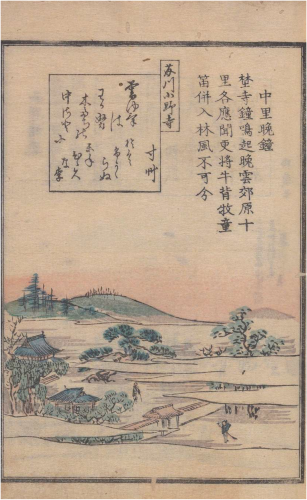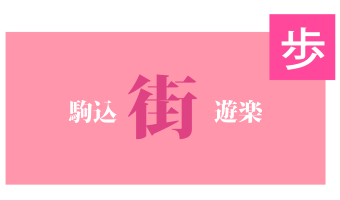|
D. 江戸の桜の川下り 谷田川・藍染川下りルート / Cherry blossom tour - Down the Yatagawa/Aizomegawa route |
||
| かつて染井の地で咲いた桜の花びらは、谷田川に舞い散ると、やがて藍染川と名称を変える流れにのって、不忍池まで運ばれて行きました。江戸時代にはあった美しい川の流れに思いを馳せながら、四季折々の表情を見せる江戸名所を巡る旅をお楽しみください。 | ||
|
Once, the cherry blossom petals scattered in Somei drifted slowly down the Yatagawa River into the Aizomegawa River, renamed at a certain point in time, and were carried down to the Shinobazu Pond. Enjoy the various spots this journey takes you to as you follow the gentle flow of the river, beyond time and beyond the seasons. |
||
|
|
||
|
|
||
|
|
||
|
|
||
|
|
||
|
|
||
|
|
||
|
|
||
|
|
||
|
|
||
|
|
||
| ①西福寺→②佛寶山無量寺 / (1) Seifuku Temple (2) Buppozan Muryo Temple | |

『江戸名所図会. 第3』142ページ |
『江戸図説』には「染井 稲荷御手洗にて染井というあり、今は埋まりて其形残ル、此井ある故に染井と地の名を呼りとそ、此寺より見落とす景色、西ヶ原遠村一ト目に詠め、絶景いわんかたなし」と記されいる。 此寺とは西福寺のことであり、染井から無量寺のある西ヶ原方面の眺めが非常にすばらしかったことが窺える。 また、『江戸名所図会』本文中には、この周辺について、「西光院と号す。同所(染井村)北の方、西原にあり。真言宗にして、弘法大師の作の不動尊を本尊とす。開山は行基菩薩なり。本堂にかくる「南無阿弥陀仏」の額は播随意院了碩和尚の筆なり。阿弥陀堂(本堂の右にあり。本尊は行基菩薩の作、六阿弥陀仏第三番目なり)。」とある。
According to the "Edo Zusetsu", “Somei: Somei is a spring located within the Inarimitarai shrine. Although it has been buried, its shape remains. The name Somei bestowed on this area originates from this spring. Looking out from the temple, one can have a glimpse of Nishigahara and of the villages across the entire region, truly a view beyond words.”
The temple refers to the Seifuku temple, and gives a glimpse of the extraordinary view of Somei and the Nishigahara area within the Muryo temple. In addition, according to the “Edo Meishozue” in regards to the area: “Referred to as Saikoin. It is located north of Someimura in Nishihara. Belonging to the Shingon sect, the main object of worship is Kobo Daishi’s Fudo Myoo. The temple is founded by Gyoki Bosatsu. The picture of “Namu Amida Butsu” inside the temple is the work of Banzuiin Ryoseki Ojo. It is a temple hall that houses Amitabha (Located to the right of the main temple building. The main object of worship is the work of Gyoki Bosatsu. The third temple within the six Amitabha temples).” |
| ③光明山園勝寺 / Komyosan Ensho Temple | |

『江戸名所図会. 第3』141ページ |
『江戸名所図会』本文中には光明山圓勝寺について、「中里にあり。浄土宗にして、本尊阿弥陀如来は慈覚大使(円仁、七九四~八六四)の作、脇士二菩薩は恵心僧都(源信、九四二~一〇一七)の作なり。開山は深蓮社聖法上人。当寺、始めは御成内竜の口にありしとぞ。勢至堂(本堂の右の方、少しの丘山の上にあり。三尊の弥陀仏を安ず。ともに仏工春日の作なり。いま、ゆゑありて勢至堂と唱へり)。」とある。 また、この寺の鐘のことが、飛鳥山からの景観美を漢詩や和歌、絵画に表現した飛鳥山十二景詩歌の「中里晩鐘」に詠まれている。
According to the “Edo Meishozue” in regards to the Komyosan Ensho temple: “Located in Nakazato. Belonging to the Pure Land sect, the Amitabha that is the main object of worship is the work of Jikaku Daishi (En'nin, 794-864), and the Kyoji Junibosatsu the work of Eshin Sozu (Genshin, 942-1017). The temple is founded by Shinrensha Hijiribo Shonin. This temple was first located in the Onarinai Ryu no Kuchi. Within the temple is the Seishido (Located to the right of the main temple building, slightly on top of the hill. The Amitabha of the Buddha triad is enshrined here, and is the work of the Buddhist craftsman Kasuga. Due to certain circumstances, it is currently called Seishido).”
In addition, the bell in this temple is portrayed in the “Nakazato Bansho”. “Nakazato Bansho" is a part of the Asukayama Juuni Keiwaka that depicts the beautiful scenery seen from Asukayama expressed in Chinese poetry, classic Japanese poetry, and pictures. |

『飛鳥山十二景詩歌』「中里晩鐘」 |
| ④田畑八幡宮 / Tabata Hachimangu | |

『江戸名所図会. 第3』138ページ |
道灌山から続く田園的な風景の中央に田畑八幡宮がある。この周辺は江戸末期まで開発されることがなかった。遠くに見える山の周辺を荒川が流れていたと見られるが、将軍吉宗は鷹狩りのルートとして船で荒川を遡航し、飛鳥山で鷹狩りをした後、染井の植木屋へ立ち寄り、一服したといわれている。 『江戸名所図会』本文中には、田畑八幡宮について「同所(西の方)にあり。田畑村の鎮守とす。相伝ふ、文治五年(一一八九)頼朝公(源頼朝、一一四七~九九)勧請す。すなはち駒込神明宮と同時の鎮座なりといふ。別当は真言宗東覚寺と号して、弘法大使の作の不動尊を本尊とす。開山は行基菩薩なり。」とある。
Tabata Hachimangu is located in the middle of the country landscape extending from Doukanyama. This area had not been developed before the end of the Edo period. It is assumed that the Arakawa River ran in the vicinity of the mountains seen in the distance. It is said that the shogun Yoshimune sailed upstream by boat on the Arakawa River as his falconry route, and after his falcon hunting on Asukayama, he would stop by at a gardener's workplace in Somei for a short rest.
According to the “Edo Meishozue” in regards to Tabata Hachimangu: “Located in the west. Local deity of the villages in the fields. According to legend, in the 5th year of the Bunji period (1189), Yoritomo (Minamoto no Yoritomo, 1147-1199) welcomed in a new deity. It is said to have been enshrined at the same time as Komagome Shinmeigu. The shrine chief is called Shingonshu Tokakuji, and the main object of worship is Kobo Daishi’s Fudo Myoo. It is founded by Gyoki Bosatsu.” |
| ⑤道灌山聴虫 / Doukanyama Mushigiki | |

『江戸名所図会. 第3』114ページ |
遠くは日光・筑波山が、一望できる道灌山の夜の景色である。 ござを敷いた3人が、酒を飲みながら月をゆっくりと眺め、虫の音を楽しんでいる。 目を移すと、虫かごを持った子どもと女連れが何やら楽しげに会話をしているように見える。 とても優雅な月夜の光景である。
With Nikko and Mt. Tsukuba in the distance, it is a sweeping night view from Dokanyama.
Three people laze on the mat, peacefully gazing at the moon as they drink and listen to the insects chirp. Shifting one’s eyes, a child holding an insect cage and two women accompanying him seem to be happily conversing. It is a very elegant scene of a moonlit night. |
| ⑥日暮里惣図(ひぐらしのさとのそうず) / Higurashi no Sato no Sozu |

『江戸名所図会. 第3』103-108ページ 「日暮里総図」 , 斎藤幸雄 ,有朋堂書店,昭和2年 |
|
はるか遠くに筑波山や日光山が浮かんで見える。挿絵の日暮里は果てしなく見渡すことができる高台である。一帯は寺社の庭園が谷中から道灌山方面まで続く花の名所。春は桜、秋は紅葉等、四季折々の花が咲き乱れ、景色の美しさのあまり日の暮れるのも気付かないということから「ひぐらしの里」と呼ばれたのだという。 挿絵をよく見ると、低地には農村が広がる。田や池に恵まれ、水辺には夏になると蛍が美しい名所もあった。 低地から坂を上っていくと中腹に広い道があり、まちの風景を楽しんでいる人々が見える。左へ行くと道灌山、右へ行くと寛永寺方面である。 台地上は寺社が点在するが、高台の向こう側は崖になっており、崖下に流れる川をめがけ、厄よけなどの願いを込めて皿を投げる”かわらけ”投げの遊びが盛んに行われたと言われている。
Mt. Tsukuba and Nikko come into sight in the far distance. This is an elevated spot where one can endlessly enjoy the view. The region is a place famous for its flowers, with temple and shrine gardens extending from the valley towards Dokanyama. With cherry blossoms in the spring and red leaves in the fall, flowers bloom in abundance from season to season. The scenery is so beautiful that the sky grows dark without one noticing, giving this place the name Higurashi no Sato (twilight village).
Looking closely at the picture, farm villages spread out in the lowlands. Bountiful in fields and ponds, a place known for its fireflies glowing by the water is also depicted. Going up the hill from the lowlands, there is a wide road where people can be seen enjoying the town scenery. The left leads to Dokanyama, and the right towards Kan’ei Temple. Temples and shrines are scattered on the plateau, and on the other side of the high ground is a cliff. It is said that earthenware-throwing games were once actively held, where plates were thrown towards the river below the cliff with prayers to ward off evil and the like. |
| ⑦東叡山寛永寺 / Toueizan Kan'ei Temple | |

『江戸名所図会. 第3』58ページ |
かつて、上野の山には、藤堂家の下屋敷があったが、天海僧正がこの地を、江戸城の鬼門にあたるとして寺院建立を将軍家光に請願した。 東の比叡になぞらえ東比叡と称し、比叡山延暦寺と同じく、建立された寛永の年号をとって寛永寺となり、将軍霊廟の地とされた。その際に、藤堂家はその替地として染井の地を賜り下屋敷を移した。 挿絵の中にも「此辺さくら多し」と見られるように、将軍家光の頃から、吉野より桜の植樹がさかんに行われ、例年花見の客で賑わった。しかし、将軍家霊廟の地となったことから、宴会などの取締りが厳しくなり、徐々に新天地を求めて谷中、日暮里へと連なる丘に沿って、新たな名所が作り出されていくこととなった。
Once, the Toudou clan's suburban residence was located on Ueno Mountain, but Tenkai Soujou requested that the shogun Iemitsu have a temple built here to protect the northeast of Edo Castle, a direction considered unlucky.
Modeled as the "eastern Mount Hiei", it was originally named Touhiei, and similar to how Hieizan Enryaku Temple was named after the era is was built in, the temple was called Kan'ei Temple after the Kan'ei era and designated as a gravesite for shoguns. In return, the Toudou clan was given the land at Somei and moved their suburban residence there. As can be seen in the part of the illustration labeled "many cherry trees here", many cherry trees were transplanted here from Yoshino during the reign of shogun Iemitsu, bringing numerous visitors to see their blossoms year after year, but after becoming a shogun resting place, the rules regarding festivities in the area became stricter. This caused people to search for new places to enjoy themselves, and several famous spots came to be formed along the hills running from Yanaka to Nippori. |
| ⑧不忍池蓮見 / Shinobazu Pond Hasumi | |

『江戸名所図会. 第3』52ページ |
本文中にある中島弁財天社は、寛永寺建立の際、寺の山号を比叡山にならって東叡山としたことにちなみ、この池を琵琶湖に見立てて小島をつくり、弁財天を祀ったことがその始まりとされる。 挿絵は、湯島天神から見た風景である。数々の浮世絵にも描かれているとおり、春の季節には多くの花見客で賑わったが、この池の蓮の花もまた、初夏の風物詩として古くから有名であった。
The Nakajima Benzaiten Shrine described in this text was inspired by the Kan'ei-ji Temple that was established and coined with the mountain honorific Toeizan, which took its name from Mt. Hiei, and its pond has a small island representing the scenery of Lake Biwa. Its history began when the deity Benzaiten was worshiped there.
The illustration is said to have been drawn from the Yushima Tenjin. The location was crowded with many visitors in the spring as seen in the Ukiyo-e painting, and the lotus flowers of this pond were famous as a feature of the early summer from old times. |

 前の画面へ戻る
前の画面へ戻る